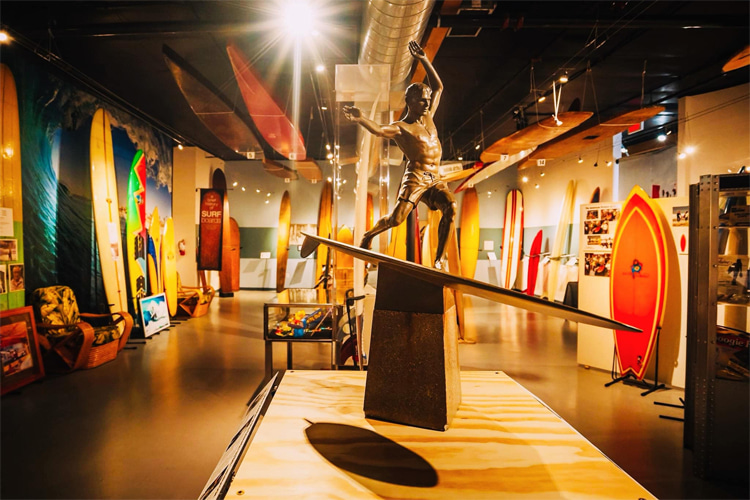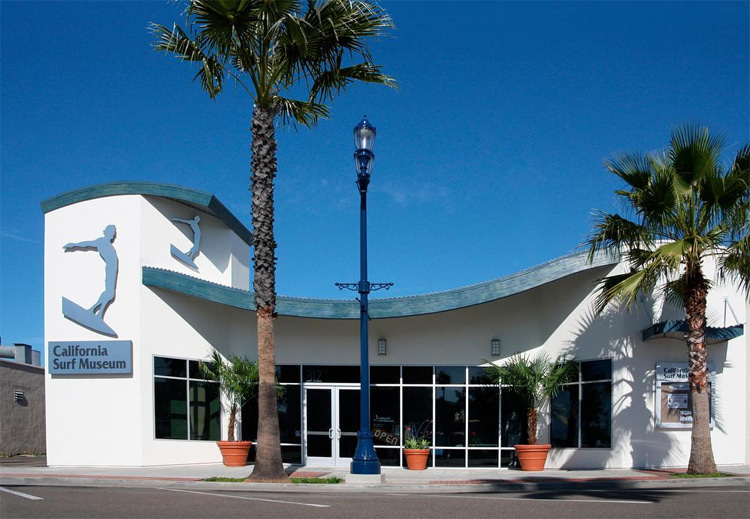The story of the California Surf Museum

It's arguably the world's richest and most culturally relevant surfing museum. The California Surf Museum is a living entity that preserves the past to understand the present and project the future of surfing.
The road to excellence is more often Z-shaped than linear, and, many times, it's the hardships and challenges that truly make the finish line sweeter.
The life of the California Surf Museum (CSM) is a virtuous circle of increments of ambition and greatness where all sorts of contributions are welcome.
And its humble start takes place by the beach with a simple goal: to preserve and celebrate surfing's rich history.
Since opening its doors, the California Surf Museum has welcomed over 650,000 visitors from all 50 states and 68 countries.
In 2023, it was named the number two "Best Attraction for Sports Fans" in the USA Today Readers' Choice Awards.

A Humble Beginning in Encinitas
In February 1986, a group of enthusiasts gathered at George's Restaurant on Coast Highway in Encinitas.
Among them were surfers and non-surfers united by a shared appreciation for the sport's multidisciplinary universe and influence.
So, led by figures like Jane Schmauss, Mike Cates, and others, the original founding board of directors laid the foundation for what would become a treasured Golden State institution.
In the beginning, the kick-off efforts were quite obvious.
The museum had to focus on assembling surfboards, photographs, and surf-related memorabilia. And there was so much to do.
The early collection artifacts were initially displayed in an alcove within George's Restaurant.
By 1988, the young museum had secured a rent-free space at Moonlight Plaza, a newly constructed shopping center in Encinitas, thanks to the generosity of local businessman Paul Rotsheck.
Not bad for a start.
The new location offered greater visibility and allowed the museum to host its first official exhibit, "Surfing: Trestles to Tourmaline," which opened to the public on September 28, 1988.
Expanding to Pacific Beach
With momentum building, the museum soon sought a larger audience.
In 1989, CSM moved to a new location within the Promenade Shopping Center on Mission Boulevard in Pacific Beach.
You could easily say that this pivotal moment marked the beginning of its adventure southward toward becoming a cultural landmark for the entire San Diego region.
By this time, the sport was also getting more and more popular among people who had never stood up on a surfboard.
Therefore, although the Pacific Beach location was a step forward, the museum was still searching for a space that could accommodate its ever-growing collection and provide a proper venue for events.
But a vision is the sum of constructive layers, time, and opportunity, and the CSM knew to wait.
Big Growth in Oceanside
The defining moment came in 1991 when museum member Dave Hanson struck up a conversation with a local real estate agent.
The chat led to an unmissable opportunity: the chance to occupy a vacant bar called The Pride's Inn on North Pacific Street in Oceanside, directly across from the iconic Oceanside Pier.
The property owners, Jim Keenan and Jim Watkins made a generous offer to allow the museum rent-free use of the building and the entire city block until they were ready to develop the land.
Though the location was ideal, the building was far from ready for a museum.
The former bar required extensive renovations to transform it into a space suitable for displaying surfing artifacts and hosting visitors.
Volunteers from the community, alongside local businesses, poured countless hours and resources into the project.
By the end of 1991, the museum had a new home, and it hired its first employee, Rich Watkins, a Vietnam veteran and long-time surfer, as administrator.
Watkins was a key figure in shaping the museum's character during its formative years.
Also, with its larger beachfront location, the museum could host events that drew surfers and wave-riding enthusiasts of all ages.
Among these gatherings was the first "Old Timers' Day" in 1993, which honored early California surfing legends such as Whitey Harrison, Faye Baird Fraser, and Phil Edwards.
The museum was quickly gaining recognition as a hub for the surfing community, a place where history was not just preserved but celebrated.
Meeting Museum Standards at Pacific Coast Highway
Despite its success at the Pacific Street location, the building's condition left much to be desired.
Structural and weather-related issues made it clear that CSM would eventually need to relocate.
By 1995, the City of Oceanside recognized the museum's importance and offered a space at the corner of North Coast Highway and Pier View Way.
Formerly a Rexall drugstore, the new location provided high visibility in Oceanside's downtown district, even though it had less space and no outdoor gathering area.
However, trade-offs are part of everyday life, and the decision was to pack and go. Again.
The move was another labor-intensive project.
With the help of generous donations, including financial support from the clothing company No Fear and exhibit cases provided by Glenn Sundby, founder of the International Gymnastics Hall of Fame, the museum adapted the space to suit its needs.
The new CSM officially opened its doors on July 5, 1997.
Before the new millennium, the museum began implementing modern, up-to-date museum standards.
With the purchase of collections management software, it embarked on the monumental task of digitizing its growing archives.
And there was so much work to do.
Imagine cataloging all surf magazines, photographs, and other memorabilia available, ensuring their preservation for future generations.
By 2007, the museum's dedication to documenting surfing history culminated in the publication of "Surfing in San Diego," a photo book that captured decades of stories and images.
The Move to a Permanent Home
Fortunately, the museum's reputation kept growing, and so did the demand for a larger, more permanent facility.
Could CSM be planning yet another move?
By the early 2000s, it was clear that the North Coast Highway location could no longer meet the needs of its expanding collection and visitor base.
In 2006, the City of Oceanside offered a new site at 312 Pier View Way.
The proposed new space, three times larger than the previous one, required major renovations to meet museum-quality standards.
Originally designed by architect and board member Louise Ravera Balma, the building featured a distinctive wave motif on its façade, reflecting the museum's theme.
Construction began in 2008, and the museum moved into its new home in 2009.
The new home of CSM provided ample room for exhibits, events, and administrative functions.
It also included a dedicated archive space, workshop, and a larger store.
And then, its proximity to the beach, pier, and hotels only cemented its influence as the place to be to learn more about surf history and formally honor its personalities.
Preserving Surfing's Treasures
CSM has meticulously assembled one of the world's most comprehensive collections of surfing memorabilia.
Its impressive archives boast over 17,000 items, including surfboards, trophies, artwork, magazines, music, oral histories, and rare documents.
These valuable and historic artifacts are regularly brought to life through permanent and rotating exhibits that explore key moments, individuals, and innovations in surfing history.
Among its highlights is the "The Science of Surfing" exhibit, which invites visitors to get to know more about the relationship between science and modern surfing.
Funded by a City of Oceanside COVID-19 grant, this STEAM-aligned display welcomes people of all ages and makes it an especially invaluable educational tool for schools.
CSM's education committee partners with community organizations to create programs like state-wide photo competitions.
Events and Celebrations
Over the years, CSM has become a very active center for the surfing community, hosting hundreds of events, including film screenings, panel discussions, book signings, and its annual members' party.
The museum's gala fundraiser has grown into a major event, featuring the prestigious Silver Surfer Award, which honors individuals who have significantly contributed to surfing culture.
Since its inception in 2009, 33 recipients have been honored for their enduring impact on the sport.
From 2008 to 2011, the California Surf Festival brought live music, movies, and workshops to Oceanside.
Well-known participants included Bruce Brown, director of the timeless "The Endless Summer," professional surfer-musician Donavon Frankenreiter, and many others.
Worth a Visit
The California Surf Museum (CSM) is a 501(c)(3) nonprofit organization (EIN: 33-0215579). It is located at 312 Pier View Way, Oceanside, CA 92054.
It's definitely worth a visit and, ideally, with time to spare.
The 3,000-square-foot (280-square-meter) exhibit hall and store are open daily from 10 a.m. to 4 p.m.
The admission fees are $7 for adults, $5 for seniors, military, and students, and free for kids under 11 and CSM members.
Words by Luís MP | Founder of SurferToday.com
